Here’s a Punjabi Mango Pickle that’s authentically our family heirloom recipe and brimming with robust flavors. Essentially a mango pickle recipe is made with tangy unripe green mangoes, spices, salt and oil. This Mango Pickle or Aam Ka Achar is a recipe which is sour and makes for the tastiest accompaniment with any Indian meal because of the choicest of spices that are used to make it. So, this summertime, pick the good green mangoes, prep up and go for this pickle recipe.
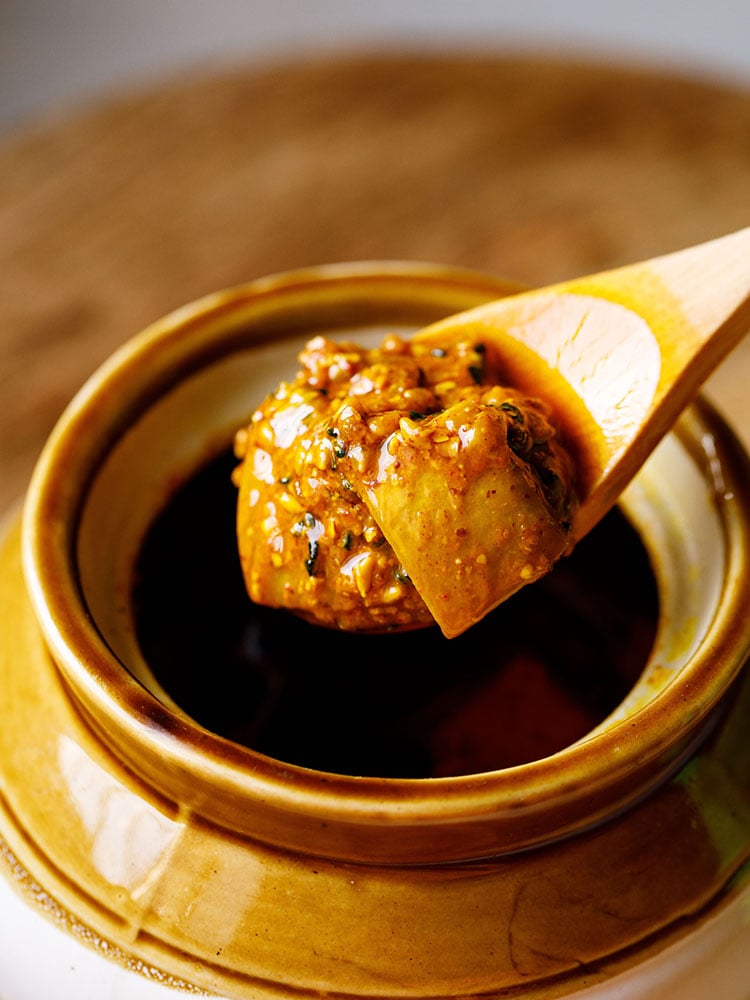
Table of Contents
India – The Pickle Nation
When one mentions India, one has to also mention about the plethora of pickles that the Indians are fond of. The Mango Pickle being one of the most loved ones, followed by Lemon Pickle, Amla Pickle, Red Chilli Pickle and other versions made with seasonal fruits and veggies.
Just like how curries or samosa is synonymous with India, so is pickles. In fact, an Indian thali (platter) is quite incomplete without a portion of pickle in it, and it can be rightly termed as one of the most favorite condiments here.
Pickles pan India are found under different monikers. For instance, ‘achaar’ in Hindi, ‘oorugai’ in Tamil, ‘loncha’ in Marathi, ‘athanu’ in Gujarati, etc. It is one of those foods that help in clearing the palate in between dishes and can elevate an otherwise boring meal.
Although the origin of the word pickle lies in the Dutch word ‘pekel’ meaning ‘brine,’ the ‘achaar’ has its origin in a Persian term meaning ‘fruits or vegetables which are salted/powdered and preserved in a solution of vinegar, salt, syrup or honey.’
About Mango Pickle Recipe
Besides being the most apt choice for parathas, dal-chawal or any other rich Indian gravy in a rice or bread combination, this Aam Ka Achar is well received not just by Indians, but also people around the world.
This is why this particular mango pickle is a sure shot hit!
- It is super easy to make. All you have to do is mix up the mango pieces with salt, spices and put it in lots of sunshine for 3 to 4 days.
- Next, you just douse good quality mustard oil and keep the jar safely in a cool, dry place for another 3 to 4 days.
- By this time, it’s ready for you to indulge in!
This Punjabi Mango Pickle recipe is my mother-in-law’s special. She had learnt it as it passed down from her mother-in-law. We Indians really take pride in such valuable recipes that are nothing less than a treasure.
There are numerous ways an Aam Ka Achar is made pan India with each pickle having a distinct flavor and method of preparation.
As you travel through our country’s length and breadth, you will find people pickling raw mangoes, in both sour and sweet versions and enjoying them with their everyday meals.
I am quite a pickle person and like to pair everything from dal, vegetable stir-fries, roti and paratha with a variety of pickles.
If you love pickles just as I do, I’m so sure that you are going to fall in love with this Mango Pickle.
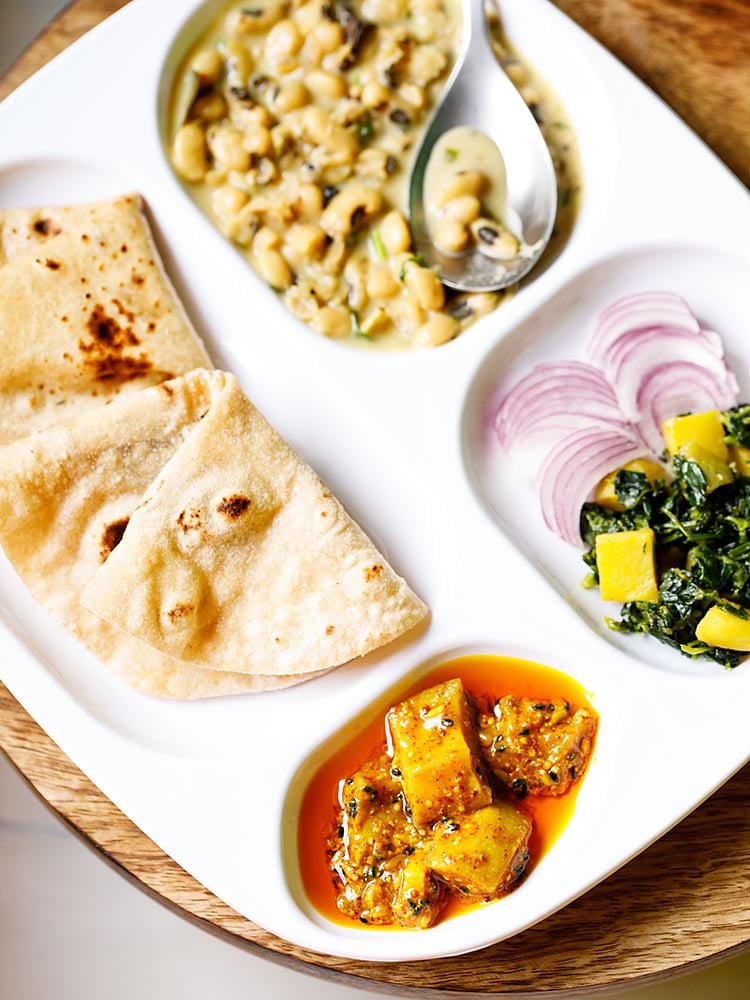
How to make Mango Pickle Recipe
Prep Spices
1. Before you begin, take the spices and salt in small bowls and keep them in sunlight for 1 to 2 hours. This step is optional but does help in getting rid of any moisture from the spices and salt.
Spices added to this pickle recipe are:
- Fenugreek seeds – ¼ cup
- Fennel seeds – ¼ cup
- Mustard seeds (can use either black or yellow) – ¼ cup
- Nigella seeds (kalonji) – ¼ cup
- Turmeric powder (ground turmeric) – 3 tablespoons
- Red chili powder or cayenne pepper – ¼ cup
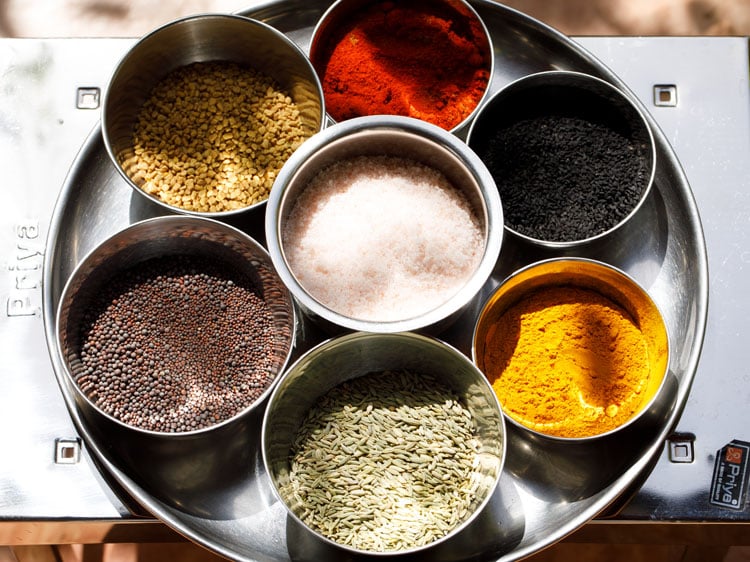
2. Later, take the fenugreek seeds and mustard seeds in a dry grinder jar or a spice-grinder.
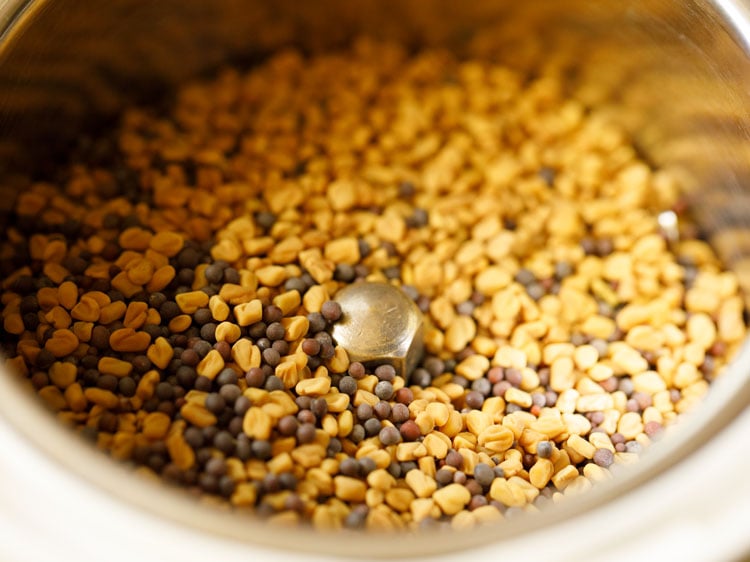
3. Grind to a coarse mixture. Do not make a fine powder.
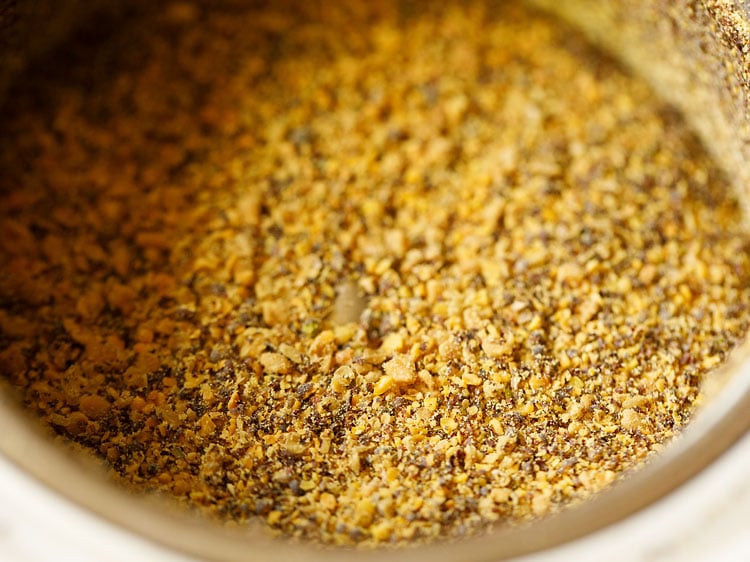
Prep Mangoes
4. Rinse and wipe the raw mangoes well with a clean kitchen towel. You can even let the mangoes dry naturally.
In the photo you only see two mangoes as they were very large mangoes weighing 1 kilogram together.
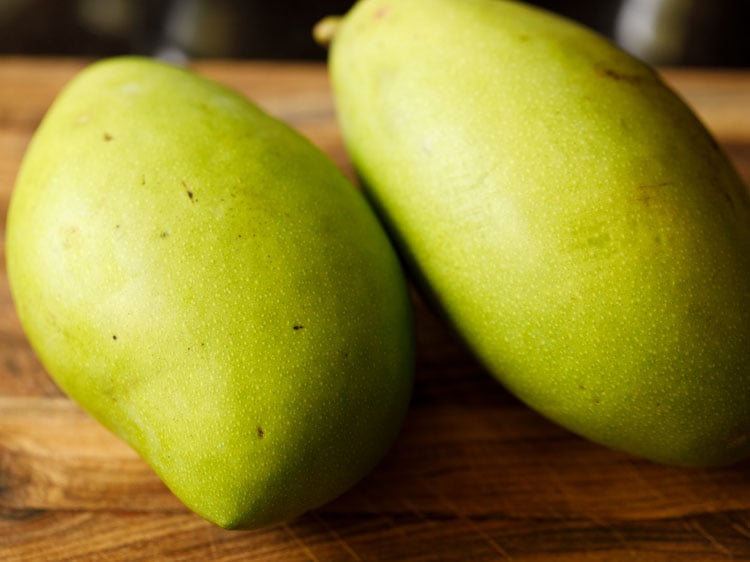
5. Chop the mangoes into 1.5 inches pieces. Discard the stones but do peel off the flesh from the stones, if any.
No need to remove the outer skin of the mangoes if they are tender and soft. You will need 7 to 7.5 cups chopped mangoes.
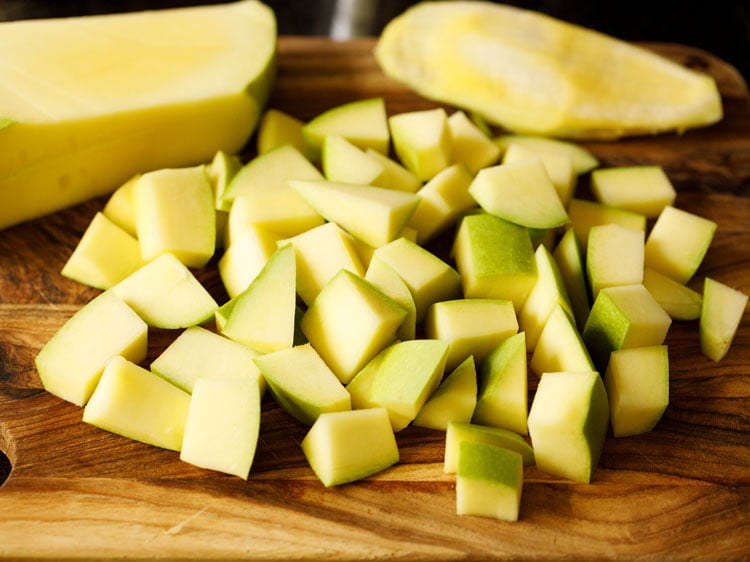
6. Take the chopped mangoes in a large mixing bowl. Better to use a steel or a glass bowl as they are non-reactive.
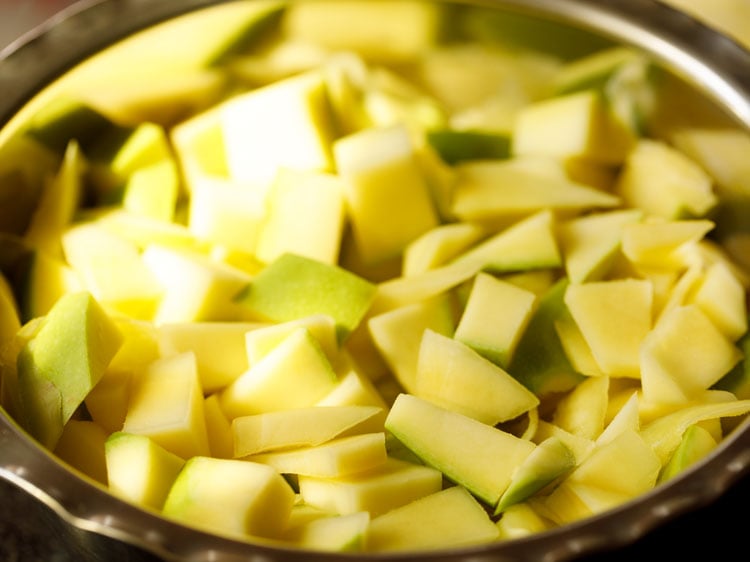
Make Pickle Mixture
7. Now firstly, add the ground fenugreek seeds and mustard seeds.
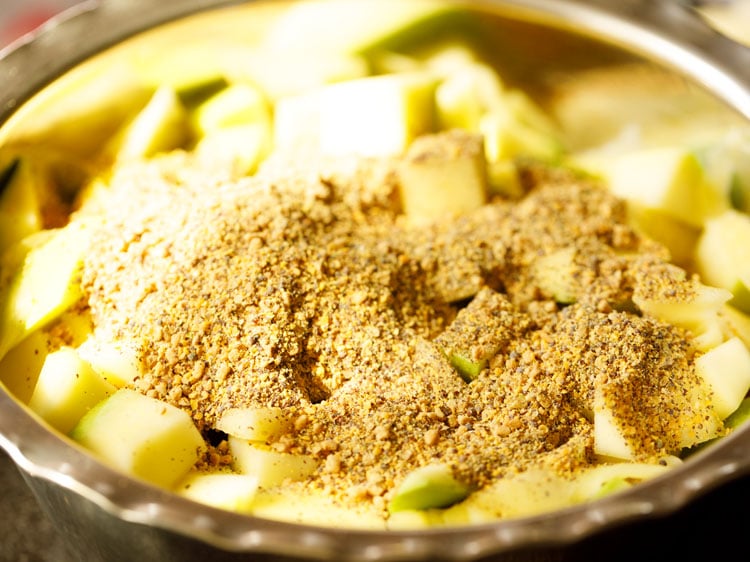
8. Then, add the remaining spices – fennel seeds, nigella seeds, turmeric powder and red chili powder or cayenne pepper.
I have added two types of red chili powder – Kashmiri red chili powder (for color) and a spicy red chili powder.
You can use even just one type of red chili powder or even a mix of cayenne pepper and paprika.
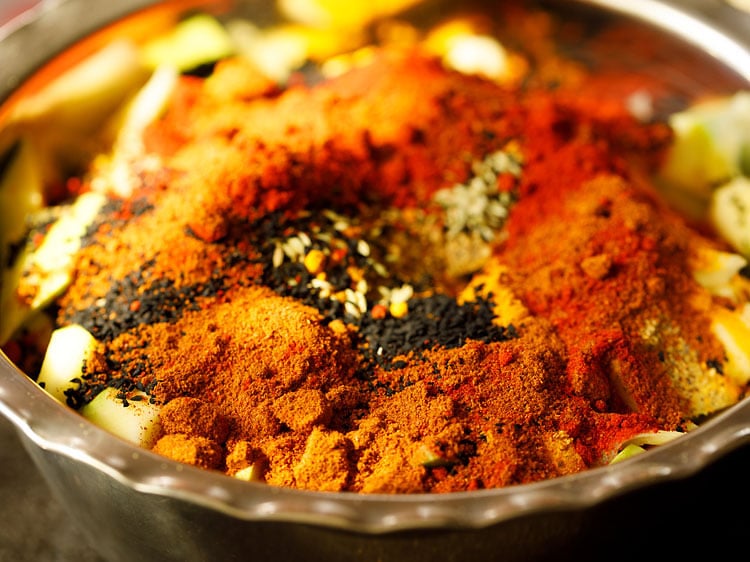
9. Next, add salt.
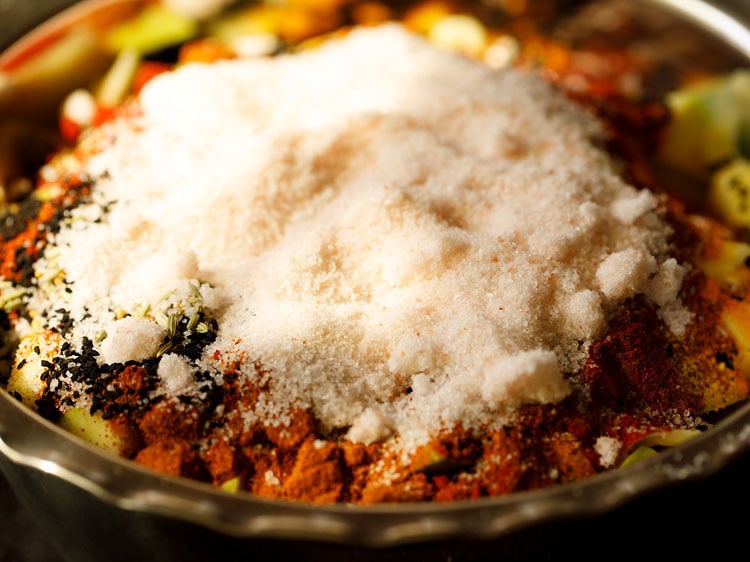
10. With a steel or wooden spoon, mix very well so that the spices uniformly coat the mango pieces.
Check the taste of the pickle masala mixture or 1 to 2 mango pieces. The taste should be slightly salty. If not, then add more salt.
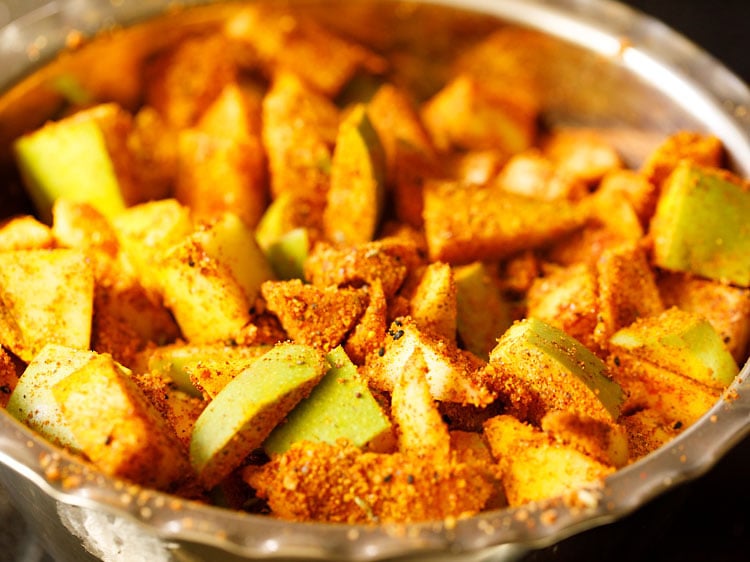
11. Now, pour ½ cup mustard oil.
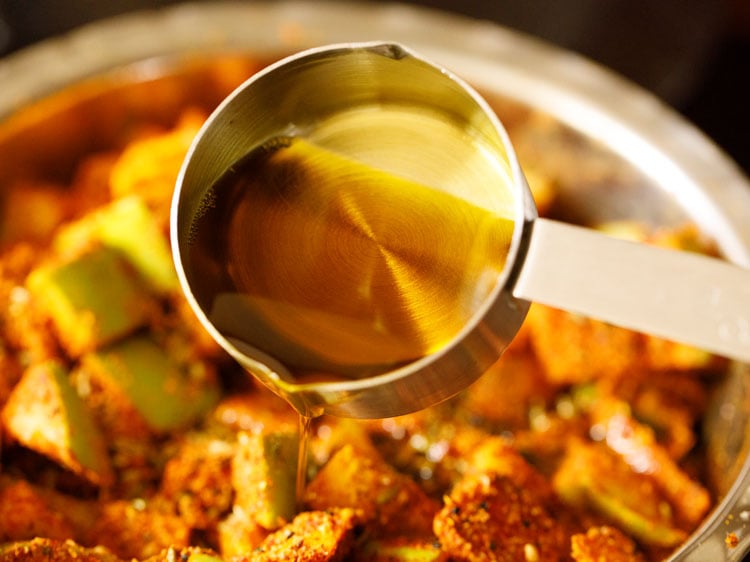
12. Mix very well.
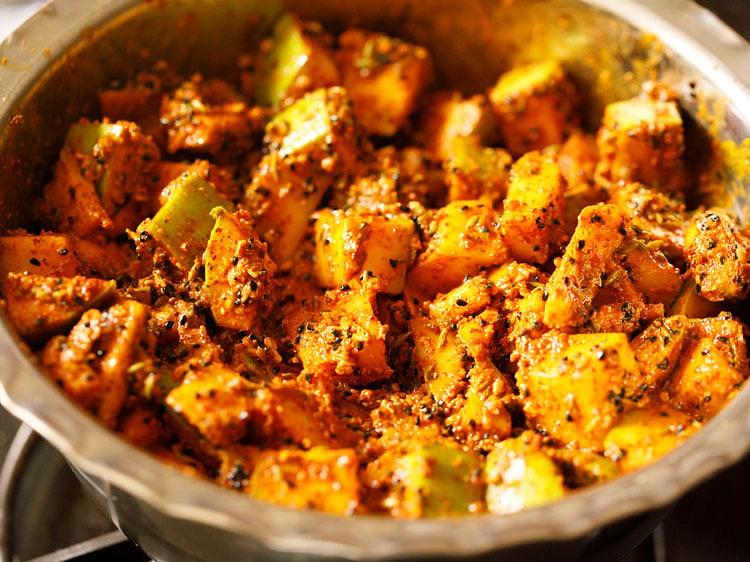
13. Spoon the prepared pickle mixture in a clean ceramic jar or glass jar. Use a clean spoon.
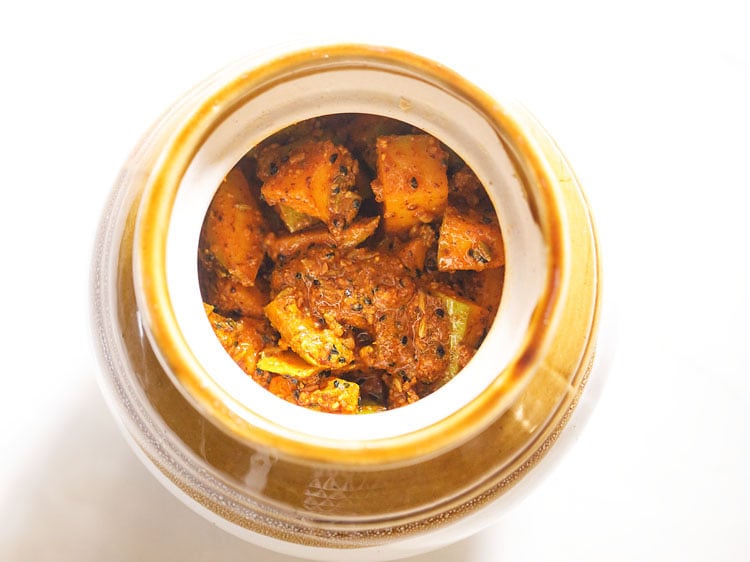
Sun Dry Mango Pickle
14. Seal with a lid and keep in sunlight for 3 to 4 days. I used two jars. Note that the sunlight should be very good with strong sun rays falling on the pickle jar.
It should not be cloudy or dark. In the evening, get the jar inside and keep in a cool dry place. Next morning, keep in sunlight again.
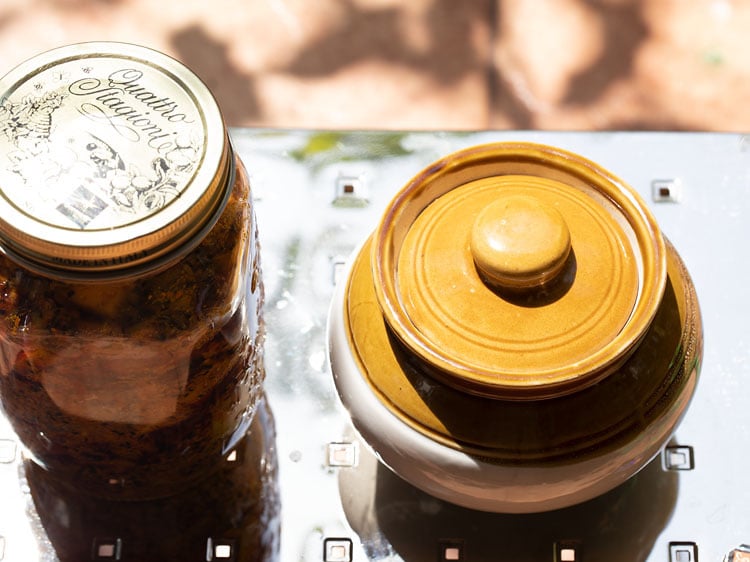
15. Everyday after sun-drying in the evening, open the lid and give a gentle mix to the pickle with a clean spoon.
This is the pickle being mixed on the first day. Take the mango pieces settled at the bottom upwards in the jar and give a thorough mix. Basically, mixing and tossing needs to be done everyday.
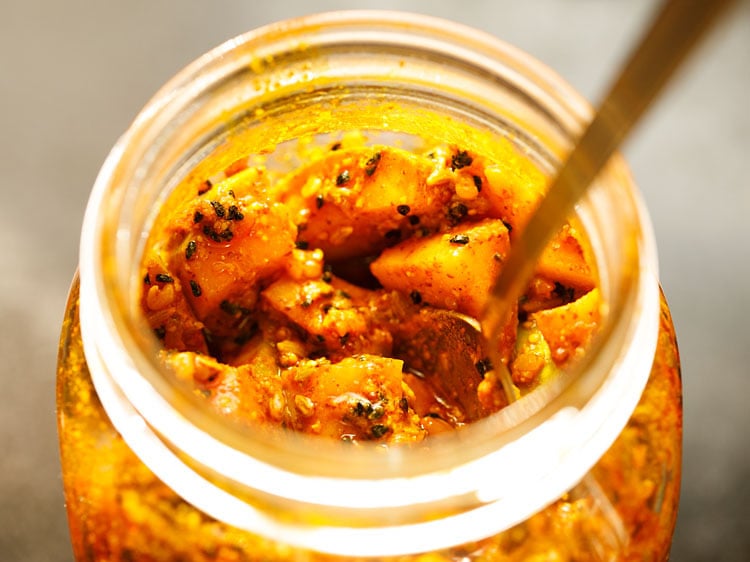
16. The below photo is of the pickle on the third day. You can see the oil floating.
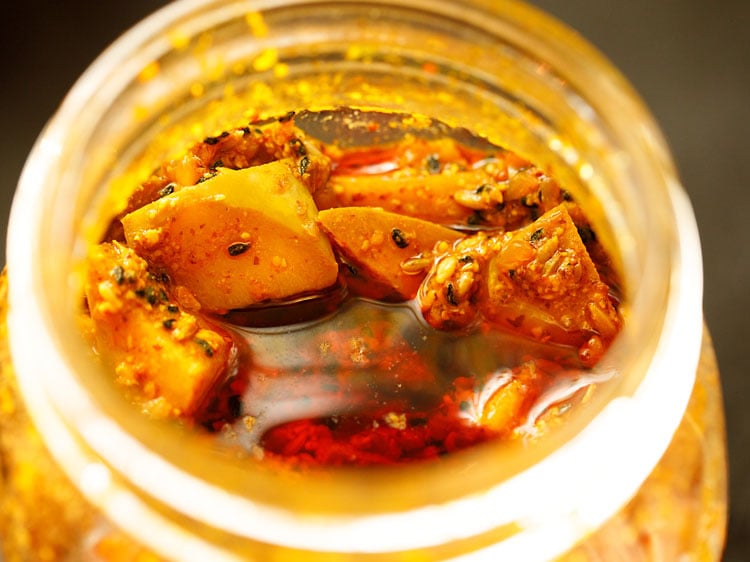
17. The pickle after mixing on the fourth day.
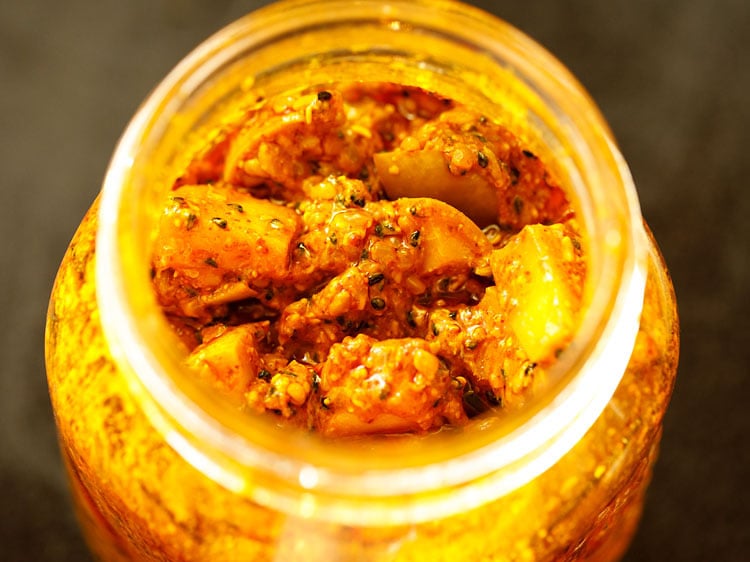
18. On the last day, pour 2.5 cups of mustard oil in the jar.
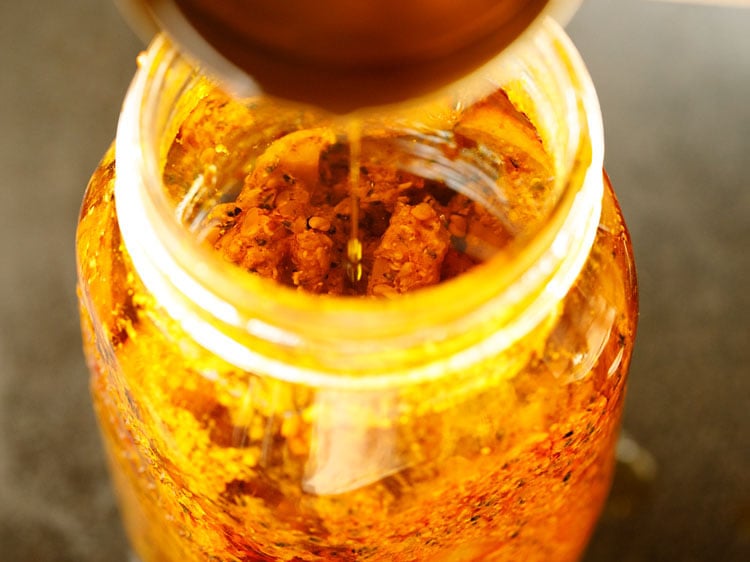
19. Again with a clean spoon give a thorough mix. The oil should seep inside and reach the bottom of the jar. All the mango pieces should be surrounded with some oil.
You do not need to heat the mustard oil. You can add more mustard oil if required. The mustard oil should float above the pickle by 2 to 3 inches. Always remember to keep the oil floating above the pickle.
Seal with a lid and keep in a cool dry place for 4 days until everything gets mellowed and pickled.
Initially, you may find a slight bitter taste in the pickle, but after 6 to 7 days, the bitterness will go away.
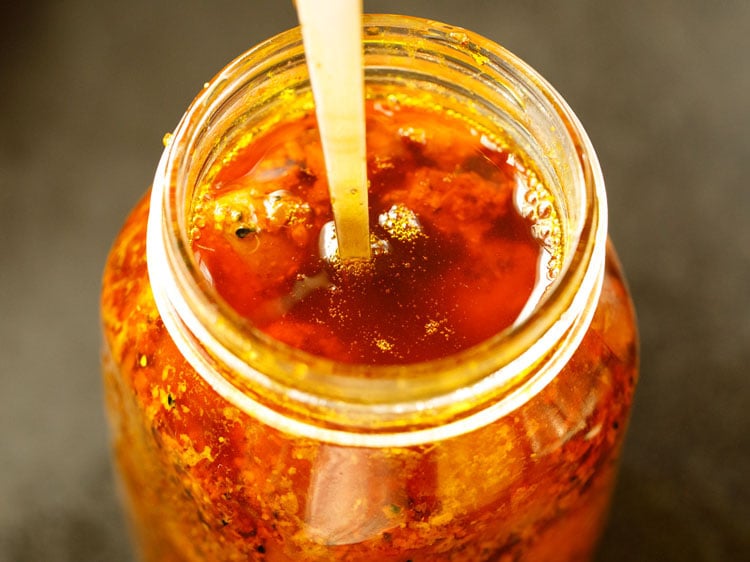
20. Enjoy the Mango Pickle or Aam ka Achar with any Indian meal. The pickle stays good for more than a year at room temperature without refrigeration. Keep the jar in a cool dry place.
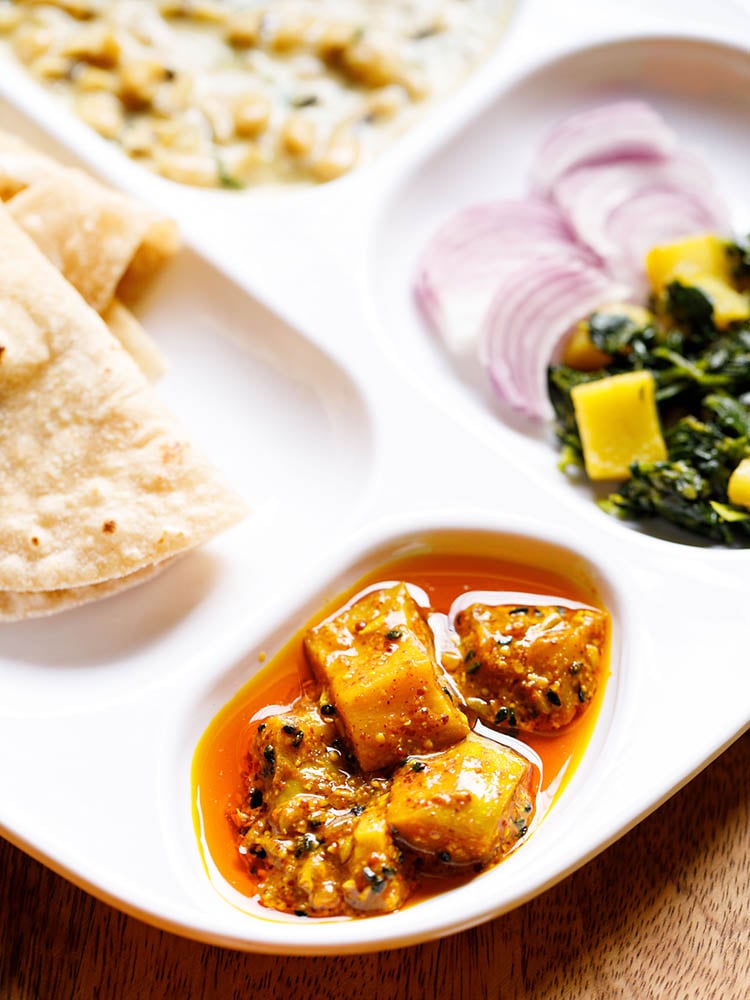
Serving Suggestions
Remember to store the pickle jar in a cool dry place. To serve, I would suggest to take a small portion of the pickle for a week or 15 days in smaller jars or bowls. Keep this jar or bowl on your dining table, kitchen or in the fridge.
While taking the pickle from the jars, always use a clean dry spoon. Make sure there is no water or moisture on the spoon as this can spoil your pickle.
In North India, apart from the usual way of consuming the Mango Pickle with meals, it is also served with flatbreads like Aloo Paratha, Paneer Paratha or any other paratha for that matter.
One of the most favorite childhood memories of ours includes we taking parathas with Aam Ka Achar in our lunch box.
When speaking of being a side condiment, the Mango Pickle tastes excellent with some rice-lentils, Curd Rice or other curries with rice.
This Punjabi Mango Pickle can also easily elevate a simple meal of even chapati or roti with any vegetable dish. Otherwise, mix the pickle masala with steamed rice and enjoy a simple and comforting, yet heavenly meal.
And while you lose yourself to the awesomeness of the sour Mango Pickle, this Avakaya Pickle is another recipe that you must try till the mango season lasts.
Make Pickle Without Sunlight
While it is absolutely paramount to have sunlight to make any traditional pickle, I have worked on a Punjabi Mango Pickle recipe that can be made sans the sun too.
You simply have to mix everything and pour it in a jar. But, do these before:
- Heat mustard oil till it smokes, and then cool it to room temperature. Add to the spiced mango pieces mixture.
- Make it a practice to cover this pickle with 2 to 3 inches layer of mustard oil on top in the jar.
- Close the lid of the jars tightly. Keep the jars in a dry place for about 5 to 6 days or more until the mangoes soften and tenderize.
- Do remember to stir the pickle with a dry and clean spoon once every day. Cover the jar again with a lid and continue to store it in a dry place until the pickle is ready.
Expert Tips
- Get raw mangoes with tender skin and use without peeling the skin. In case the mangoes have tough skin, then peel and use.
- Make sure to always use fresh spices. Take them on a plate and then discard the husks and stones, if any.
- Grind the mustard and fenugreek seeds coarsely for this pickle. You can also use store-brought split mustard and fenugreek seeds.
- You can add more or less red chili powder depending upon the level of spiciness you want in the pickle.
- The jar used to store the mango pickle should be thoroughly sterilized, cleaned and dried. Preferably use a glass jar or ceramic jar. Do not use plastic jars.
- Keep in mind the hygiene and cleanliness while making any pickle, jam, sauce, preserve or for that matter any food.
- This Aam Ka Achar recipe can be scaled accordingly.
FAQs
I would suggest not to store this mango pickle in a plastic jar. Try to use a ceramic jar or a good sturdy glass jar.
This mango pickle will stay good for more than a year. Even if the pickle is not sun-dried or partially sun-dried, it stays good for more than a year. Cover the pickle with a generous layer of oil as well to keep it good.
One way to soften the mangoes is just heating through, but not boil. Once the pickle is hot, let it cool on its own and don’t cover with a lid. However, you can cover with a pan, cotton napkin or muslin cloth. Make sure the water doesn’t condense as this might spoil the pickle.
Choose mangoes that are raw, firm and a dark green in color with a white-colored flesh. If the flesh is yellow, it means the mango is slightly ripe.
Store this pickle in a ceramic jar by putting a muslin cloth on the mouth, later securing it with a string and then putting the lid.
Use either. Both work well in this pickle recipe.
Moisture in the pickle will result in fungus. Avoid this by covering the pickle with a thick layer of oil and keeping it dry. Any mould or fungus means you have to discard the entire pickle and there is nothing you can do to rectify it.
You can prepare this pickle with sesame oil or sunflower oil.
Preferably, the pickle has to be sun-dried. If not, then it can be dried under the fan too. But this will reduce the shelf-life as otherwise sun rays kill microorganisms.
You needn’t discard the water as it gets evaporated while the pickle is sun-dried.
More Indian Pickle Recipes To Try!
Pickle Recipes
Pickle Recipes
Pickle Recipes
Pickle Recipes
Please be sure to rate the recipe in the recipe card or leave a comment below if you have made it. For more vegetarian inspirations, Sign Up for my emails or follow me on Instagram, Youtube, Facebook, Pinterest or Twitter.
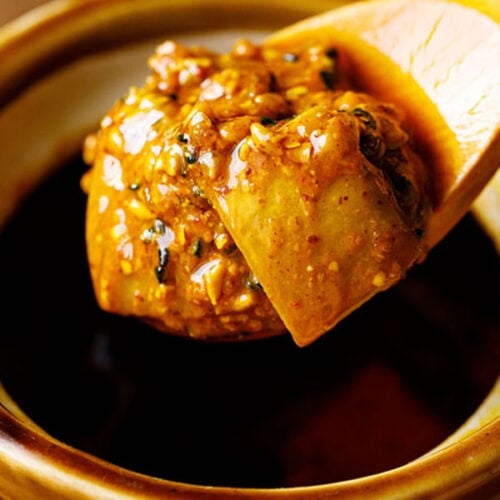
Mango Pickle | Punjabi Aam ka Achar Recipe
Ingredients
- 1 kilogram mangoes or 7 to 7.5 cups of chopped mangoes – unripe and green
- ¼ cup mustard seeds – 40 grams, black or yellow or 40 grams split yellow mustard seeds
- ¼ cup fenugreek seeds – 45 grams or 45 grams split fenugreek seeds
- ¼ cup fennel seeds – 30 grams
- ¼ cup nigella seeds (kalonji) – 30 grams
- 3 tablespoons turmeric powder (ground turmeric) – 15 grams
- ¼ cup red chili powder or cayenne pepper – 25 grams
- ½ cup rock salt (edible and food grade) – 125 grams or add as required – can also add regular salt or pink salt
- 3 cups mustard oil – add more if required
Instructions
Prep Spices and Mangoes
- Before you begin, take the spices and salt in small bowls and keep them in sunlight for 1 to 2 hours. This step is optional but does help in getting rid of any moisture from the spices and salt.
- Later, take the fenugreek seeds and mustard seeds in a dry grinder jar or a spice-grinder and grind to a coarse mixture.
- Rinse and wipe the raw mangoes and let them dry naturally. You can even wipe them dry with a clean kitchen towel.
Making Mango Pickle
- Chop the mangoes into 1.5 inches pieces. and add them in a bowl. Discard the stones but do peel off the flesh from the stones, if any. No need to remove the outer skin of the mangoes if they are soft and tender.
- Take the chopped mangoes in a large non-reactive mixing bowl.
- Now begin by adding the ground fenugreek seeds and mustard seeds first.
- Then, add fennel seeds, nigella seeds or onion seeds, turmeric powder, red chili powder and salt.
- With a steel or wooden spoon, mix very well so that the spices uniformly coat the mango pieces. Check the taste of the pickle masala mixture or 1 to 2 mango pieces. The taste should be slightly salty. If not, then add some more salt.
- Next pour ½ cup mustard oil.
- Mix very well.
- Spoon the prepared pickle mixture in a clean ceramic jar or glass jar. Use a clean spoon.
- Cover with a lid and keep in sunlight for 3 to 4 days. Note that the sunlight should be very good with the strong rays falling on the pickle jar. It should not be cloudy or dark.
- Everyday after sun-drying in the evening, open the lid and give a gentle mix to the pickle with a clean spoon. Take the mango pieces settled at the bottom upwards in the jar and give a thorough mix. Basically, mixing and tossing needs to be done everyday.
- In the evening, get the jar inside and keep in a cool dry place. Next morning, keep in the sunlight again.
- After keeping in sunlight for 3 to 4 days, add the remaining 2.5 cups mustard oil. Again with a clean spoon, mix very well. The oil should seep inside and reach the bottom of the jar. All the mango pieces should be surrounded with some oil.
- Note that you do not need to heat the mustard oil. You can add more mustard oil if required. Do keep in mind that the mustard oil should float above the pickle by 2 to 3 inches. Always remember to keep the oil floating above the pickle.
- Seal with a lid, keep in a cool dry place for 4 days till everything gets mellowed and pickled.
- Initially, you may find a slight bitter taste in the pickle, but after 6 to 7 days, the bitterness will go away. This Mango Pickle stays good for more than a year at room temperature without refrigeration.
- Enjoy this Punjabi Mango Pickle with any Indian meal.
Notes
- Make sure the spices are within their shelf period and have not gone rancid.
- Use good quality mustard oil and preferably cold pressed or wood pressed.
- Instead of mustard oil, you can use sesame oil (made from raw sesame seeds) and sunflower oil. But keep in mind that the taste and flavor of the mango pickle made with either of these oils will be different.
- Note that the approximate nutrition info is for the entire jar of Mango Pickle.
Nutrition Info (Approximate Values)
This Mango Pickle recipe post from the archives first published on May 2012 has been updated and republished on April 2023.
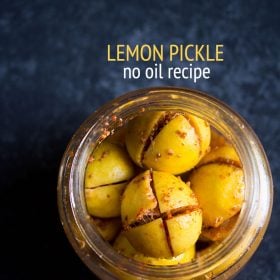
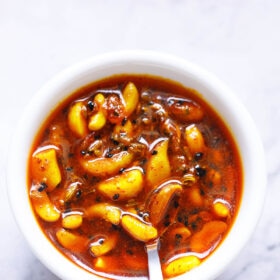
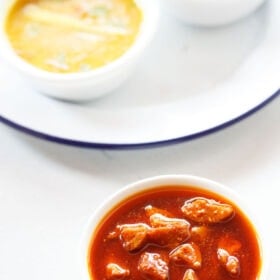
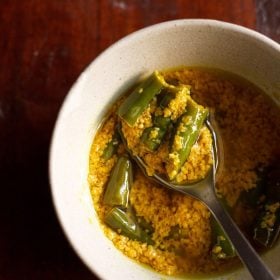
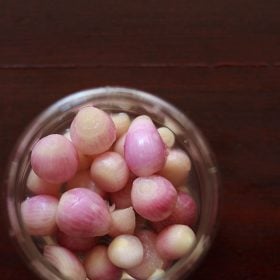
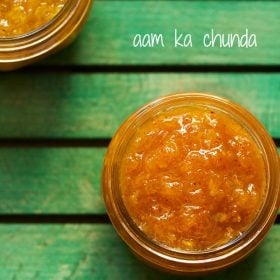
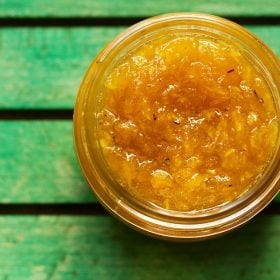








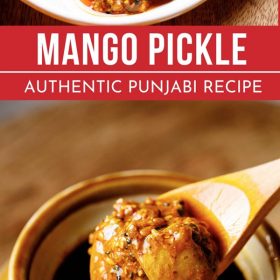
hi
I made this mango pickle I think two months ago. But I have to admit … I live in Holland and we have not very hot summers. So I did sun dry the mangoes but I guess that the mango’s did not completely dry. But I followed your procedure as good as I could (next time I will dry the mango’s in the oven I think).
But now when I taste the pickles, the taste is very good but the mango’s are still very hard, after two months. Why is this ? And is there something I can do to soften the mango’s. There is plenty of mustard oil in the bottle
jan, usually the mangoes do soften after pickling for a few months. i assume that the mangoes have got sun dried too much and thats why the hardness. usually the mangoes do not become hard. or it could be the quality of mangoes – like having less water content in them. one way is cooking the pickle. just heat through but do not boil. with this method the mangoes can soften a bit. once the the pickle has got hot, then let it cool down on its own. do not cover with a lid or you cover the pan with a cotton napkin or muslin. water should not condense as then the pickle can get spoiled.
ok Dassana. I will try.
But in India you have very hot days in summer, most of our summer days are 20-25 degrees celsius. So I think that I should forget to sun dry the mango’s and better dry them in the oven for 3-4 hours.
Would love to make some good pickles myself. I also did make your lemon pickle recipe without oil and nimbu ka achaar recipe. The lemon pickle without oil is great !!!
I made the nimbu ka achaar with limes (because our lemons have rather thick skin. And I think this pickle also has rather hard lime pieces ….
I will let you know if cooking the mango pickle did work
fine jan. yes of course you can try doing the oven method. it will work. i will be sharing one more version of lemon pickle made in kerala style in some time. the nimbu achar which is posted and which i do make on occasions has soft lime pieces. i am wondering why the lemon or mango pieces are becoming hard. usually for most pickling recipes, i keep the pickle for 2 to 3 days in the sun and in the night i keep the pickle inside. you can also try the mango avakaya (spicy andhra mango pickle)which does not need heavy sunlight. the recipe i have shared is large in quantity and stays good for a year, but you can halve the recipe.
sure do let me know how the cooking goes about.
could you say something about how the mango’s should look like (or feel) and how you can see they are ok for making pickles ?
jan, the mangoes should be firm, feel hard and have a green to dark green color. the flesh should be firm and white colored. a pale yellow colored flesh indicates that the mango has ripened slightly.
hey dassana ..
Ur recipes are just wowww.
please help I have dried mangoes but because of monsoon there is no sunlight can I dry them under the fan it’s a second day and I have to kept it in the room what should I do please reply soon
thank you
radhika, you can dry them under the fan. no issues.
Hey i have dried the pickle in sun for 4- days and now have added oil but after 5 days it is still very hard n not softened a bit. I am very scared wht should i do ??
it will soften. don’t worry. keeping in the oil for a longer time, will soften it.
Please help i dried the mango with masala for 3 days as suggested in recipe even after adding mustard oil its been 7 days and the mangoes taste like amchoor rather than pickle . i have been making this pickle from past 3 years never had this problem as i used to dry only for a day instead of 3 the pickle used to be soft and juicy but now its become very hard what do i do
no worries. after soaking them in oil for some days, the mango pieces will soften. looks like the mango pieces have become too dry. if you keep the mango pieces in the jar for a few weeks, then they will soften. as the pickle matures, it will soften much more.
Just about to make the punjabi mango pickle Could u please tell me the exact quantity (measure) for salt? Last time I went wrong with the salt! Thank u
mini, 2 to 3 tablespoons of salt should be fine. just mix everything and taste the masala. if you feel salt is less, then you can a few teaspoons or tablespoons more of the salt.
Wow and super.
thank you vashu 🙂
Ma’am can you please post the recipe of green chilli pickle that stays good for 1year or so..
kannu have taken your request for green chili pickle recipe that will last for a year. but for now you can check this recipe of green chilli pickle, which stays good for some months – green chilli pickle
I have tried many recipes of yours like Dal tadka, Mango Dal, Palak Dal, Methi Dal and some Paneer recipes. Always everyone enjoyed it. Now I am attempting the Punjabi Aam ka Achar. In your recipe the spices are mentioned for 5-6 mangoes. What will be the approximate weight of these mangoes. Continue to add more recipes.
thank you geney. these mangoes were between small to medium sized. they were not big ones. the weight should be around 400 to 500 grams.
Hi there,
If I have a bharni jar with me, how can I cover them with the mixed mangoes in it? Do I need to tightly cover them or just close them as usual way? Because I have seen people tying a piece of plastic over the mouth of the jar and later covering the pot with the usual lid.
simi, put a piece of muslin cloth on the mouth of jar. it should be secured with a string and then keep the lid.
Dear dasana,
It has been 2 years and you have still remained my favourite recipe site. Your simplicity of ingredients and visual instructions are very very helpful. You are my go to person if I want to plan a meal. Even my mother has been impressed with my cooking and asked for recipes when I make some of your dishes. Hats off to you for taking the time and effort in sharing this wealth with us mere mortals.
thank you very much tanvi. your words means a lot to me. keep cooking and sharing the love with your family and friends.
Hi amit…
Can we dry it by pre heating the oven. Or any other method of sun drying without actually keeping it out in sun…
pooja, i have dried mango slices in the oven. so i think you can dry. have a look at this post of amchur powder, where in step by step pics you can see the mango slices being dried in the oven. you can use the same temperature as mentioned in this post. about the timing you will need to keep a check, so that the mangoes do not dry out too much. here is the link – https://www.vegrecipesofindia.com/amchur-powder-recipe-dry-mango-powder/
Thanks amit.. Can u put it in the oven with the masala or without it.. Also do I have to set the timing in the oven for 7hr after pre heating it.
you can put in the oven with the masala. yes you will need to set the timing. i would suggest to break the time. first dry for 3 to 4 hours. check and then again continue to dry for 3 more hours. do keep a check as it the mango pieces should not become like papads and break.
Hi,
Please share which mustard seeds to be taken. Yellow one or black one. And can I dry the mango pieces for a while before applying all the masalas to it?
either can be used. you can dry the mango pieces before applying all the masalas.
HI,
Even after following your post step by step, my achar caught fungus. Though i had kept it for 7 days in sunlight without oil. What could be the possible reason? 🙁
reason can be moisture in the pickle or cleanliness. the pickle should be dry. and also keep the pickle covered with oil. what you can do is now, remove the fungus part. the fungus will be only on the top. usually when pickles start getting fungus, they get it at the top first. so remove this part. cover the pickle jar’s mouth with a muslin cloth and keep it in the sun for 2 to 3 days. also cover the pickle with 1 or 2 inch oil floating above.
While drying itself, it caught fungus in between the mango prices.I had to throw off and again started preparing. Hoping this time it won’t catch fungus. And also I don’t get enough sunlight here. Can you pls suggest what to do exactly? Will be grateful. Thanks.
okay. the sunlight should be strong and a good one, like the sunlight we have in delhi and parts of north india or in maharashtra and gujarat. what you do is keep on giving sunlight at all the times. meaning keep on changing the position of the plate to where the sunlight falls in its maximum intensity. i would also suggest to cover the plate with a meshed lid or a fine muslin cloth, so that dust particles do not settle down on the pickle. use a large plate or bowl, so that the mango pieces are distributed evenly and have enough space. looks like sunlight is an issue where you live.
a friend of mine gita, her mum used to make this and living in amsterdam hot sunny days are few so she used to dry out the green mango in a low oven and the end result was always fantastic.
thankyou milton for sharing with us 🙂
I like my mango pickle dry(at least some of it)as it is easier to carry whilst travelling and less messy.I wonder if you can just keep drying this without oil addition.How woul it work?I once had oil less mango pickle with all the masala and it was wonderful.However the lady would not part with the recipe.Do you have any recipes for dry mango pickle?
in this recipe oil is essential. i do not have any recipe of a dry mango pickle. i will check with my family members if they know of such a pickle and can try the recipe during mango season.